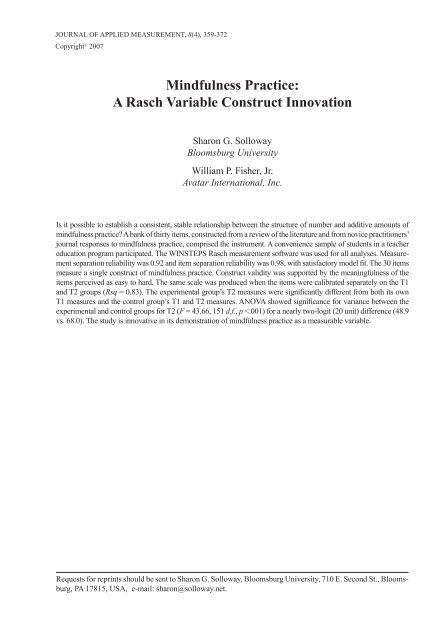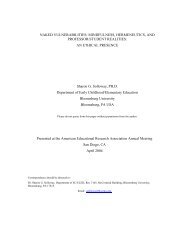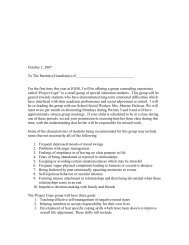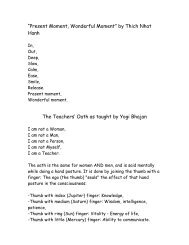Mindfulness Practice: A Rasch Variable Construct Innovation
Mindfulness Practice: A Rasch Variable Construct Innovation
Mindfulness Practice: A Rasch Variable Construct Innovation
Create successful ePaper yourself
Turn your PDF publications into a flip-book with our unique Google optimized e-Paper software.
JOURNAL OF APPLIED MEASUREMENT, 8(4), 359-372Copyright © 2007<strong>Mindfulness</strong> <strong>Practice</strong>:A <strong>Rasch</strong> <strong>Variable</strong> <strong>Construct</strong> <strong>Innovation</strong>Sharon G. SollowayBloomsburg UniversityWilliam P. Fisher, Jr.Avatar International, Inc.Is it possible to establish a consistent, stable relationship between the structure of number and additive amounts ofmindfulness practice? A bank of thirty items, constructed from a review of the literature and from novice practitioners’journal responses to mindfulness practice, comprised the instrument. A convenience sample of students in a teachereducation program participated. The WINSTEPS <strong>Rasch</strong> measurement software was used for all analyses. Measurementseparation reliability was 0.92 and item separation reliability was 0.98, with satisfactory model fit. The 30 itemsmeasure a single construct of mindfulness practice. <strong>Construct</strong> validity was supported by the meaningfulness of theitems perceived as easy to hard. The same scale was produced when the items were calibrated separately on the T1and T2 groups (Rsq = 0.83). The experimental group’s T2 measures were significantly different from both its ownT1 measures and the control group’s T1 and T2 measures. ANOVA showed significance for variance between theexperimental and control groups for T2 (F = 43.66, 151 d.f., p
362 So l l o way a n d Fi s h e ring information-weighted and outlier-sensitivemean square model fit statistics (Smith, R. M.,2004; Wright and Masters, 1982). Measures andcalibrations from Winsteps were then studiedstatistically and graphically using SPSS v. 14(SPSS, 2005).ScalingResultsThe 8-point rating scale was optimized (Linacre,1999, 2004) to three categories, with all ofthe “disagree” categories (25% of the responses)combined together, the “agree” category (37%of the responses) left intact, and three most extreme“agree” categories (37%) also combined.The transition from category 1 (All “disagree”categories) to category 2 (“agree”) calibrated to7.5 units (.75 logits) below matching measuresand calibrations, while the threshold betweencategories 2 and 3 (all other “agree” categories)calibrated to 7.5 units above matching measuresand calibrations.Overall respondent measurement separationreliability was 0.92 and item calibration separationreliability was 0.98. Logits were transformedto a roughly 0-100 scale by multiplying by 10 andadding 50. The same scale was produced when theitems were separately calibrated on the T1 and T2groups (R = 0.91). The model fit statistics do notfalsify the hypothesis that the thirty items measurea single construct of mindfulness practice. <strong>Construct</strong>validity was supported by the meaningfulnessof the item order on the variable.The items were calibrated on multiple separatesub samples of the data, determined by curriculumtype (mindfulness training or no mindfulnesstraining) and pre- or post-intervention timepoints. Correlations of the resulting calibrations,including the overall total sample calibration, forall 30 items, range from 0.87 to 0.99.Items 28 and 6 were identified by WIN-STEPS (Linacre, 2006) as having fit problems.However, omitting the items from the scale makesno difference in the resulting measures. All itemswere included in the analyses.ExperimentalAs is shown in Figure 1, the experimentalgroup’s T1 measures (mean = 50.7) were notstatistically distinct from the control group’s T1(mean = 48.9) measures (a 0.18 logit difference).As is expected, given the measurement error ofabout 4 transformed units, ANOVA yielded nosignificance for variance between the experimentaland control groups for T1 (F = 1.28, p =0.26, 1 d.f.).The control group’s measures were notsignificantly different between T1 (48.9) and T2(48.6) (F = 0.01, p = 0.91, 1 d.f.). The experimentalgroup’s measures were different to a statisticallysignificant degree (T1 Mean = 50.7 and T2Mean = 68.0; F = 72.79, p < 0.001, 1 d.f.), as isexpected, given that the 18-unit difference spansover four of the 4-unit error ranges.Limiting the T1 and T2 groups to the studentswith both T1 and T2 scores, the control groupmeasures were not significantly different in apaired samples t-test (n = 65, t = .51, p = .61, 64d.f.). The experimental group’s measures weresignificantly different (n = 86, t = –10.18, p
Mi n d f u l n e s s Pr a c t i c e 363Figure 1. Pre- and Post-<strong>Mindfulness</strong> Instruction Measures by Curriculum Typeboth the measures and the response category-levelitem calibrations plotted vertically.The average measure at T1 is about 50.Drawing a vertical line through Figure 2 at 50on the horizontal scale shows what the expectedresponses to the items are for a student with thatmeasure. Students with these initial, uninformedexperiences of mindfulness practice’s effectsstrongly acknowledge that mindfulness makesfor more attentive listening, and more mildly acknowledgea wide range of other effects, rangingfrom positive effects on others to more self controlto a new kind of happiness, with a decreasinglikelihood of agreement as one reads up the scale.Three items involving sensations (smell, touch,and sight) are more likely to elicit disagreeableresponses than agreeable ones.The experimental group’s T2 measure is 68.Again imagining a vertical line drawn throughFigure 2, this time at 68 on the scale, we nowexpect strong agreement with all but the top fiveof the mindfulness practice effects, and mildagreement is expected for these.The substantive meaning of the experimentalintervention of training in mindfulness practiceis expressed in terms of the difference betweenthese expected response patterns. The differencebetween the overall T1 measures and the experimentalgroup’s T2 measures is about 18. At T1,with an average measure of 50, the item with thehighest calibration with which all students typicallystrongly agree is item 22, mindfulness makesme a more attentive listener, which calibrates at38. At T2, with an average measure of 68, theitem with the highest calibration with which theexperimental group typically strongly agrees withis item 21, I notice more of my bodily sensations,which calibrates at 56.
364 So l l o way a n d Fi s h e rEXPECTED SCORE: MEAN (“:” INDICATES HALF-SCORE POINT)20 30 40 50 60 70 80 90|+-----+-----+-----+-----+-----+-----+-----| NUM ITEMD D : A : SA SA 19 1 M heightens my sense of smell.D D : A : SA SA 23 3 I feel like I’m seeing for the first time.D D : A : SA SA 15 1 M heightens my sense of touch.D D : A : SA SA 6 2 I notice that time loses its meaning.D D : A : SA SA 29 3 I handle all experiences with equanimity.D D : A : SA SA 21 2 I notice more of my body sensations.D D : A : SA SA 18 1 M makes me feel peaceful.D D : A : SA SA 8 1 M reduces my stress.D D : A : SA SA 4 3 I observe my thoughts without being caught up in them.D D : A : SA SA 14 2 I notice that I experience a kind of happiness that’s different.D D : A : SA SA 27 3 I notice that ordinary experiences seem extraordinary.D D : A : SA SA 20 3 I observe things objectively.D D : A : SA SA 10 3 I increase my power to intensely examine my life.D D : A : SA SA 28 2 I notice that my mind wanders frequently.D D : A : SA SA 24 3 I observe the way things constantly change from moment to moment.D D : A : SA SA 30 2 I notice things about myself I never knew before.D D DISAGREE A AGREE SA STRONGLY SA 3 1 I notice things in nature that I never noticed before.D D : A : SA AGREE SA 17 1 M teaches me to experience the world in an entirely new way.D D : A : SA SA 25 1 M is harder than I first thought it would be.D D : A : SA SA 7 3 I often find great peace and joy in ordinary experiences.D D : A : SA SA 26 3 I observe experiences while I participate in them.D D : A : SA SA 2 2 I notice the causes of my emotions.D D : A : SA SA 11 3 I have more insights.D D : A : SA SA 5 1 M makes me feel thankful for things I usually take for granted.D D : A : SA SA 16 1 M can be learned.D D : A : SA SA 12 2 I notice more control over my responses.D D : A : SA SA 13 2 I notice I feel more positive about the tasks I accomplish.D D : A : SA SA 1 2 I notice my emotions as they change during the day.DD : A : SA SA 9 2 I notice that other people like it when I listen this way.D : A : SA SA 22 1 M makes me a more attentive listener.|+-----+-----+-----+-----+-----+-----+-----| NUM ITEM20 30 40 50 60 70 80 90 10011112 2211111 1 15 3 2 4521465294465073533135459 963 6 6 1 8 STUDENTST S M S TFigure 2. <strong>Mindfulness</strong> <strong>Practice</strong> <strong>Construct</strong> MapNotice that item 21, at 56, is 18 units higherup the scale than item 22, at 38. The same 18 unitsthat distinguish the difference between the overallT1 measures and the experimental group’s T2measure also distinguish the difference betweenthe two group’s response likelihoods, respectiveto any pair of items on the scale. These relationshipsconstitute the substantive meaning of thequantitative comparisons facilitated by the scale.Any unit difference between any two points on thescale will translate into substantively meaningfulcontrasts illustrated by the content of the itemsand optimized rating scale. The constancy of thisrelationship is itself substantiated by the fit to themeasurement model, and the high correlations andlinear plots of the items’ scale values across subsample calibrations.Theory-Data ConvergenceThe numbers 1, 2, and 3 in the first columnof the item names in Figure 2 indicate the preexperimentaltheoretically predicted calibrationranges. These predicted calibration ranges correlate0.03 to 0.10 with the multiple independentsubsample recalibrations of the 30 items. Therespondents’ ordering of the items thus differsfrom the researcher’s original conceptualizationof that hierarchy, offering an opportunity for rethinkingtheory and possibly establishing a closertheory-data congruence.The theoretical order was derived from severalyears’ experience reading students’ mindfulnessjournals. It seemed evident that the empiricalfrequency with which students mentioned ordescribed various effects of mindfulness practicein their journals followed the pattern described bythe three assigned categories, with 1 emergingearliest, and 3, latest.But does the empirical order of emergencenecessarily imply a hierarchy of effects? Perhapsthe effects initially noticed are landmarks or ageneral structure within which the experience oflater effects are categorized. The group 1 itemsin fact span the entire calibration range, and seemto be marking out significantly different ranges in
Mi n d f u l n e s s Pr a c t i c e 365MEASURE | BOTTOM P=50% | MEASURE | TOP P=50% MEASURE ----PERSONS---+-ITEMS -+-ITEMS -+-ITEMS------ 100 #### + + + 100| | |. | | || | |90 + + + 90| | |### | | || | || | |### | | |80 + + + 80.# | | |### | | |.#### | | | X.#### | | | X.## | | | XX70 ## + + + X 70.## | | |.# | | |.##### | | X | XXX.# | | X | XX.###### | | XX | XX60 .## + + X + XXX 60.###### | | | X.######## | | | XXXX##### | X | XXX | XXXXX.####### | X | XX | XX######## | XX | XX | X50 ############ + X + XXX + X 50############ | | X |.#### | | XXXX | X########### | XXX | XXXXX |.####### | XX | XX |######## | XX | X |40 ####### + XXX + X + 40.##### | X | |# | XXXX | X |.## | XXXXX | |## | XX | || X | |30 # + X + + 30| | || X | |.# | | || | || | |20 + + + 20## + + + ------PERSONS-+-ITEMS -+-ITEMS -+-ITEMS------- EACH ‘#’ IN THE PERSON COLUMN IS 2 PERSONS: EACH ‘.’ IS 1Figure 3. <strong>Mindfulness</strong> <strong>Practice</strong> Wright Mapthe items, with the content of the group 1 itemssignifying a theme common to the group 2 and 3items falling in that range.That is, if a student is experiencing enhancedlistening ability as an effect (item 22, at the bottomof the scale), then it becomes possible to dothe “noticing” (category 2) items right above it,each of which may be in some degree entailedby first item.If then the student acknowledges that mindfulnesscan be learned (item 16), and experiencessome gratification in noticing what is usuallytaken for granted (item 5), then she or he is readyand able to experience the “taken for grantedthings” in the group 2 and 3 items right abovethese. When the student in due course breaksthrough the next group of category 1 items, a newlevel of critical awareness or attunement is obtained,which supports receptivity to the followinggroup of largely group 3 items. Sticking with thatcritical attunement then leads to the next group1 transition into reduced stress (item 8), and theassociated group 2 and 3 new balance, centering,and enhanced physical sensations.DiscussionRigorous measurement demands the use ofan invariant unit in an infinite sequence across
366 So l l o way a n d Fi s h e rall relevant subjects and reveals what is uniqueabout each subject. While measurement requiresa standardization of the unit, it never demandsthe standardization of the thing measured. <strong>Rasch</strong>models set up dialectic between the thing measured,the instrument of measurement and the logos of thething measured. That is “Proportion means ‘logos.’Something that is addressed in its proportion is addressedin its being,” (Gadamer, 1991, p. 143). Thelogos of the thing itself—the laws that create theproportions of the thing itself—are discovered as thething itself speaks through the mathematical voiceof the model. The voice reveals eidetic aspects ofthe thing itself establishing the logos, which inturn governs the reliability of observation as beingan observation of the thing measured and notsomething else. <strong>Rasch</strong> models establish a differencein degree as well as a difference in qualityin the measurement of a human science variablelike mindfulness practice. This characteristic ofdifference not only in degree but also in qualitymakes for an intriguing connection between mindfulnesspractice and the <strong>Rasch</strong> rating scale modelas an especially good model for establishing ameasurement of mindfulness practice.In addition, the properties of solutionsfor uncertainty and conjoint additivity makeit especially relevant when, as in this case, noestablished measurement instrument existed formindfulness practice as a variable. <strong>Rasch</strong> modelsdeal with uncertainty by building into the modela mathematical solution for estimating the probabilityof a future event given the present set ofobservations. In other words we work backwardsfrom the known data (observations) as the probableconsequences of a mathematical solutionthat makes use of the limits of relevant randomness.This solution for probability along with themodel’s property of conjoint additivity functionsto calibrate an instrument for measuring mindfulnessby letting the proportions of the variableemerge as the conditions for calibration and at thesame time measure the probability of amounts ofmindfulness for any item or person.In other words, the articulation of the itemsacross the variable made possible by <strong>Rasch</strong>’smathematical solution establish for the first timea logos or law of mindfulness practice as it isexperienced by novice practitioners. Additionalcalibrations of this and other like instrumentsacross other populations by other researcherswill further test the quantitative resilience of thislaw. When the hypothesis that the mindfulnesspractice variable persists in a stable state acrosstime, space, individual practitioners, and individualtextual representations of the particularsof mindfulness practice is not falsified, thereemerges the possibility for a “quantitative languageshared by all members of [the] researchculture” (Fisher, 2003a, p. 780). With such acommon language, variables like this one can become“formally coordinated into structured signsystem[s] capable of functioning as medium[s] forcollective, distributed cognition” (Fisher, 2003b,p. 813). Then, like any other science, the scienceof mindfulness practice may move back and forthfrom the particular to the universal as networksof interested parties collaborate in supporting itsgrowth and the articulation of its laws.ConclusionsSeveral issues present themselves for furtherstudy. First, can others reproduce the effectsmeasured here elsewhere? Second, can the revisedsubstantive theory of the variable be usedto improve the instrument? Third, what otherapproaches to mindfulness training for novicesmay be evaluated using the present instrumentto compare effectiveness in terms of growth onthe scale from pre- to post-intervention. Fourth,would studies in which participants were randomlyassigned to mindfulness practice or nonmindfulnesspractice produce similar results?The study is innovative in its demonstrationof mindfulness practice as measurable, as teachableand learnable, and as an object of experimentalresearch. The dramatic effects validate theliterature on mindfulness practice as a transformativemoment-by-moment experience (Brown,1999; Hahn, 1976; Miller, 1994; Solloway, 2003,2004). As this study demonstrates, these effectscan now be measured quantitatively. Future researchwill seek to generalize these findings toother mindfulness settings and measures.
Mi n d f u l n e s s Pr a c t i c e 367ReferencesAndrich, D. A. (1978). A rating formulation forordered response categories. Psychometrika,43, 561-574.Bond, T., and Fox, C. (2007). Applying the <strong>Rasch</strong>model (2 nd ed.). Mahwah, NJ: LawrenceErlbaum.Brown, R. C. (1999). The teacher as contemplativeobserver. Educational Leadership, 56(4),70-73.Fisher, W. P., Jr. (2000a). Objectivity in psychosocialmeasurement: What, why, how. Journalof Outcome Measurement, 4, 527-563.Fisher, W. P., Jr. (2000b). Survey design recommendations.Popular Measurement, 3,58-59.Fisher, W. P., Jr. (2003a). Mathematics, measurement,metaphor and metaphysics I: Implicationsfor method in postmodern science.Theory and Psychology, 13(6), 753-790.Fisher, W. P., Jr. (2003b). Mathematics, measurement,metaphor and metaphysics II: Accountingfor Galileo’s ‘fateful omission’. Theoryand Psychology, 13(6), 791-828.Fisher, W. P., Jr. (2004). Meaning and methodin the social sciences. Human Studies, 27,429-454.Fisher, W. P., Jr. (2005). Daredevil barnstormingto the tipping point: New aspirations for thehuman sciences. Journal of Applied Measurement,6(2), 173-179.Gadamer, H. –G. (1991). Plato’s dialectical ethics:Phenomenological interpretations relatingto the Philebus (R. M. Wallace, Trans.). NewHaven, CT: Yale University Press.Hahn, T. N. (1976). The miracle of mindfulness.Boston: Beacon Press.Kessler, S. (1991, Winter). The teaching presence.Holistic Education Review, 4-15.Linacre, J. M. (1999). Investigating rating scalecategory utility. Journal of Outcome Measurement,3, 103-122.Linacre, J. M. (2004). Optimizing rating scalecategory effectiveness. In E. V. Smith, Jr. andR. M. Smith (Eds.), Introduction to <strong>Rasch</strong>measurement (pp. 258-278). Maple Grove,MN: JAM Press.Linacre, J. M. (2006). WINSTEPS <strong>Rasch</strong> measurementsoftware [Computer program].Chicago: WINSTEPS.Mayes, C. (1998). The use of contemplativepractices in teacher education. Encounter:Education for Meaning and Social Justice,1(3), 17-31.Miller, J. P. (1994). The contemplative practitioner:Meditation in education and the professions.Wesport, CT: Bergin and Garvey.Miller, J. P. (2006). Educating for wisdom andcompassion. Thousand Oaks, CA: CorwinPress.Napoli, M. (2004). <strong>Mindfulness</strong> training forteachers. Complementary Health <strong>Practice</strong>Review, 9(1), 31-42.O’ Reilley, M. R. (1993). The peaceable classroom.Portsmouth, NH: Boynton/Cook PublishersHeinemann.<strong>Rasch</strong>, G. (1960). Probabilistic models for someintelligence and attainment tests. Copenhagen,Denmark: Danish Institute for EducationalResearch. (Expanded edition, 1980. Chicago:University of Chicago Press.)Smith, R. M. (2004). Fit analysis in latent traitmeasurement models. In E. V. Smith andR. M. Smith (Eds.), Introduction to <strong>Rasch</strong>measurement (pp. 73-92). Maple Grove, MN:JAM Press.Smith, E. V., Jr. (2004). Evidence for the reliabilityof measures and validity of measureinterpretation: A <strong>Rasch</strong> measurement perspective.In E. V. Smith, Jr. and R. M. Smith (Eds.),Introduction to <strong>Rasch</strong> measurement (pp. 93-122). Maple Grove, MN: JAM Press.Solloway, S. G. (1999a). The contemplative practitioner:The full presence of the professor inthe teacher education classroom. The Journalof the Oklahoma Association of Teacher Educators,3, 36-48.Solloway, S. G. (1999b). Teachers as contemplativepractitioners: Presence, meditation,
368 So l l o way a n d Fi s h e rand mindfulness as a classroom practice.Unpublished dissertation, Oklahoma StateUniversity at Stillwater, OK.Solloway, S. G. (2000). Contemplative practitioners:The project of thinking gaze differently.Encounter: Education for Meaning andSocial Justice, 13(3), 30-42.Solloway, S. G. (2001). <strong>Mindfulness</strong>, the hermeneuticimagination and jouissance: Actioninquiry and transformations in classroompractice. Journal of Curriculum Theorizing,17(4), 155-170.Solloway, S. G. (2003, November). Cultivatingmindfulness: Caught in the gaze of themoreness of life. Paper presented at Centerfor Equity and <strong>Innovation</strong> in Early ChildhoodConference, University of Melbourne,Melbourne, Victoria, Australia.Solloway, S. G. (2004, April). Naked vulnerabilities:Intersections of mindfulness,hermeneutics, and professor/student realities.Paper presented at the annual meeting of theAmerican Educational Research Association.Solloway, S. G. (2005, April). Compassion asa radical form of criticism: A quality of theteacher’s presence—the calibrated flesh asgenerous language. Paper presented at theannual meeting of the American EducationalResearch Association.SPSS, Inc. (2001). SPSS for Windows, Rel. 11.0.1.[Computer program]. Chicago: Author.Varela, F. J., Thompson, E., and Rosch, E.(2000/1991). The embodied mind: Cognitivescience and human experience. Cambridge,MA: MIT Press.Wright, B. D., and Masters, J. N. (1982). Ratingscale analysis. Chicago: MESA Press.Wright, B. D., and Mok, M. (2000). <strong>Rasch</strong> modelsoverview. Journal of Applied Measurement,1, 83-106.
Mi n d f u l n e s s Pr a c t i c e 369Appendix ADevelopmental <strong>Mindfulness</strong> Survey ItemsBeginning Understandings/Knowing/Impressions:I am learning that paying attention to what is happening right now:1. …can be learned.2. …is harder than I first thought it would be.3. …makes me a more attentive listener.4. …heightens my sense of smell.5. …heightens my sense of touch.6. …makes me notice things in nature that I never noticed before.7. …makes me feel peaceful.8. …reduces my stress.9. …makes me feel thankful for things I usually take for granted.10. …teaches me to experience the world in an entirely new way.Intermediate Understandings/Knowing/Impressions:As I practice paying attention to what is happening right now, I notice:11. …that my mind wanders frequently.12. …more of my body sensations.13. …things about myself I never knew before.14. …that other people seem to like it when I listen to them this way.15. …more control over my responses.16. …I feel more positive about the tasks I accomplish.17. …that I experience a kind of happiness that’s different.18. …the causes of my emotions.19. …my emotions as they change during the day.20. …that time loses its meaning.Advanced Understandings/Knowing/Impressions:When I practice paying attention to what is happening right now, I:21. …observe my thoughts without being caught up in them.22. …observe experiences while I participate in them.23. …often find great peace and joy in ordinary experiences.24. …feel like I’m seeing for the first time.25. …have more insights.26. …notice that ordinary experiences seem extraordinary.27. …observe things objectively.1.28. …increase my power to intensely examine my life.29. …observe the way things constantly change from moment to moment.30. …handle all experiences with equanimity.






